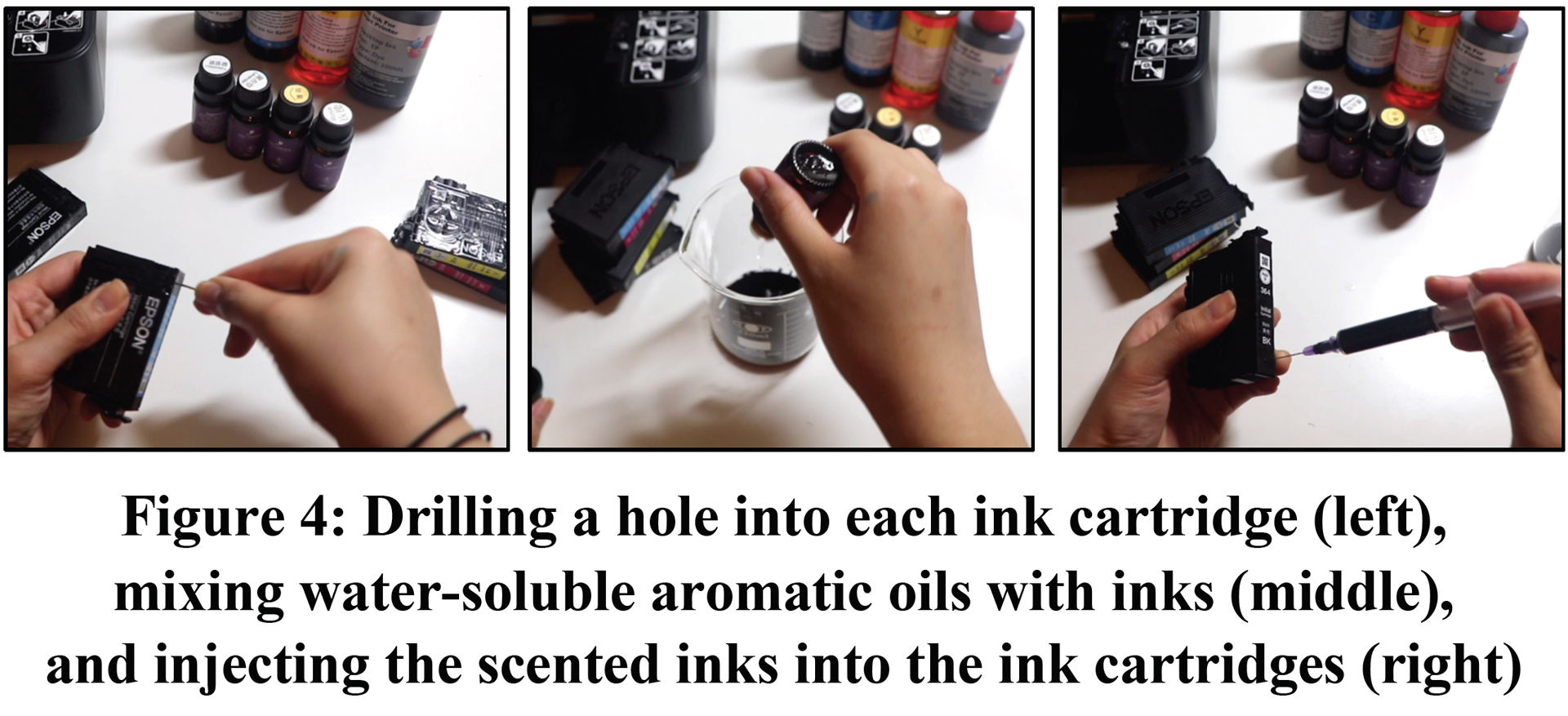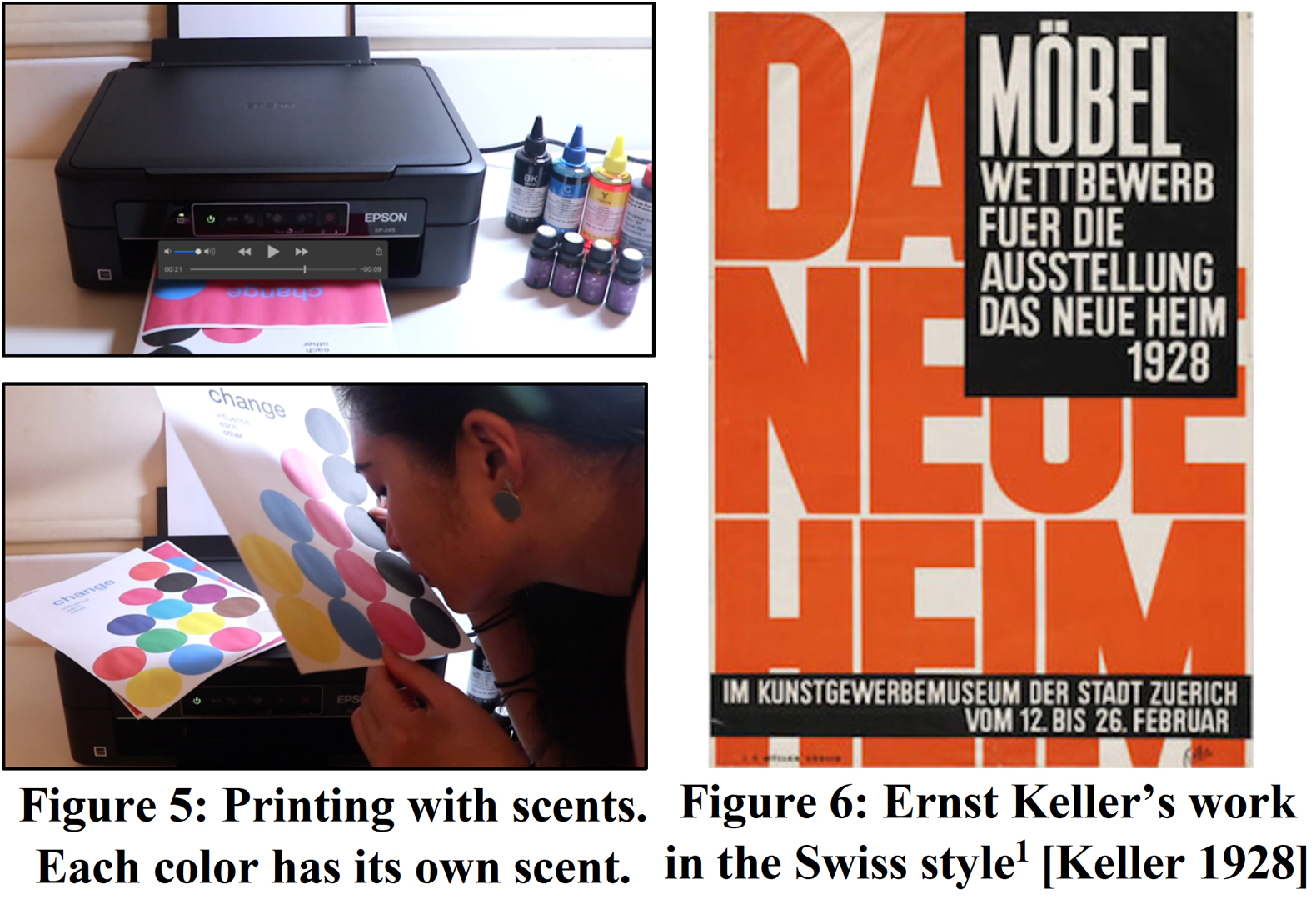“Scented Graphics” by Kang and Nishino
Conference:
Type(s):
Entry Number: 06
Title:
- Scented Graphics
Presenter(s)/Author(s):
Abstract:
Abstract
This paper describes “Scented Graphics,” our artistic experiments with a scented-printing technique that utilizes an inkjet printer. By mixing water-soluble aromatic oils with inks, an inkjet printer can be utilized to control scent mixing with high precision at almost no extra cost. Such features are hardly provided by the existing scented-printing services at the same level of flexibility and cost effectiveness. We mimicked the Swiss graphic design in our experiment as the style to facilitate the preliminary investigation of this technique. As scent mixing is a fundamental technique in olfactory art, our experiments can be beneficial as design exemplars as a preliminary exploration of the technique.
Introduction
We developed a simple hacking technique to drill a hole into each ordinary ink cartridge for inkjet printers and to inject water soluble aromatic oils. This technique is quite easy to perform and allows the precise control of the mixtures of scents almost at no extra cost. While scented-printing services are already popular, such a cost-effective high-precision control in scent mixing is not provided by existing services. As scent mixing is one of the most fundamental but important techniques in olfactory art, such a technique may be beneficial for researchers and artists in the field for further experiments in scented printing.
Related Work
As scents have a significant influence on human perception, interaction design with scents is a topic of significant interest in multisensory interaction research, and further investigation and exploration are expected. To name a few from the existing research works, there is ‘Meta Cookie’ by Narumi et al., which utilized scents together with visual processing to change the subjective taste perception of plain cookies [Narumi et al. 2011]. Sugimoto and her colleagues created an interactive olfactory display device utilizing the inkjet printing mechanism (note that this is not an inkjet printer and the device just uses the inkjet mechanism to emit scents) [Sugimoto et al. 2010]. There are also some commercial products that interactively emit scents for smartphones [ChatPerf Inc. 2013] and for head-mounted-displays [VAQSO Inc. 2018].
Description of Our Work
We utilized an ordinary inkjet printer EPSON XP-245 with the T3461-3464 ink cartridges for our work. We applied a simple hacking technique to drill a hole into each cartridge (Figure 4 left) and injected the mixture of inks and water-soluble aromatic oils into each of the cyan (C), magenta (M), yellow (Y), and black (K) cartridges (Figure 4 middle/right). Each of these inks is mixed with the scents of lavender, rose, peppermint, and rosemary, respectively. Scented printing from the inkjet printer with the hacked cartridges can be performed with a normal laptop computer (Figure 5). Designers are only required to choose colors so that the intended mixture of scents can be produced. In other words, the mixture of CMYK colors on the paper surface is directly associated with mixing scents in this version.
Figures 1 to 3 show three examples from a series of our scented printing experimental works. As shown, we used the style inspired by the Swiss graphic design [Hollis 2006] (often referred also as ‘international style’). Figure 6 shows a typical example of the style by Ernst Keller 1 in 1928 [Keller 1928]. As it uses large colored regions placed in a grid system, it is easier for the audience to appreciate the differences in scents embedded on the printed paper surface. Figure 1 (left) is a simple example using only four colors, each of which is taken from the CMYK ink cartridges. As each ink is assigned one scent, each region emits a different scent. For further experimenting, we produced some variants of the same design. For example, Figure 1 (middle) shows an example of a variation with assorted colors, in which each colored region embeds different mixtures of the four scents. By controlling the color parameters in the CMYK color space, scent mixing for each color can be performed with high precision. Figure 1 (right) illustrates a little more advanced technique that uses a color gradient. When the color gradient from one to another is used, the scents embedded in the region of the color gradient can also embed the gradual transition between two different mixtures of scents. After this initial investigation, we further investigated the design space of some variations with these techniques of color-scent mixtures and color-scent gradients. Figures 2 and 3 are design examples of such further investigations. The example in Figure 2 is designed to experiment with color scent mixtures with more complicated patterns, and the example in Figure 3 is designed to experiment with more complicated color-scent mixtures.
Discussion
Olfactory art has a long history, and scent mixture is one of the fundamental techniques in the field. While commercial scented printing services exist, such services cost both time and money. Our inkjet scented-printing would be a useful hacking technique that allows cheap and flexible experiments in scented printing, and its scent mixture can be also controlled with high precision. Such a technique can facilitates creative exploration in scented printing, and we described preliminary experiments with this technique. Yet, due to its nature, scents embedded with our technique cannot be preserved for a lengthy period, unlike some commercial scented-printing techniques (such as “scratch and sniff”). This may limit the application fields of our technique.
Conclusion
We developed a simple but effective hacking technique for scented printing with an inkjet printer. While our investigation is still in the initial stage, the technique seems quite effective both in cost and time for experiments with scented printing. We also described our preliminary experiments, which could be beneficial as design exemplars for the technique. We are planning further exploration of the technique and its application fields, such as assistive technology for visually-impaired people.
References:
- ChatPerf Inc. 2013. Scentee. https://scentee.com/_device. (2013).
- Richard Hollis. 2006. Swiss Graphic Design: The Origins and Growth of an International Style, 1920-1965. Yale University Press.
- Ernst Keller. 1928. https://commons.wikimedia.org/wiki/File:Ernst_keller_image.jpg. (2013).
- Takuji Narumi et al. 2011. Meta cookie+: an illusion-based gustatory display. In Proc. of the 2011 International conference on Virtual and Mixed Reality: New trends – Volume Part I, Randall Shumaker (Ed.), Vol. Part I. Springer-Verlag, Berlin, Heidelberg, 260-269.
- Sayumi Sugimoto et al. 2010. Ink jet olfactory display enabling instantaneous switches of scents. In Proceedings of the 18th ACM Multimedia (MM ’10). ACM, New York, NY, USA
- Vaqso Inc. 2018. VAQSO VR. https://vaqso.com/#Overview. (2013).






